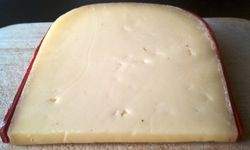By Aaron Estes, Cheese Editor
 I was not familiar with Byebrook Farms or its location, Bloomville, NY (in Delaware County) prior to this past weekend. However, after tasting one of their cheeses, I would like to learn more about it.
I was not familiar with Byebrook Farms or its location, Bloomville, NY (in Delaware County) prior to this past weekend. However, after tasting one of their cheeses, I would like to learn more about it.
After doing a quick Google map search, I saw that it is to the southeast of Oneonta, right in the middle of the Catskills. There are quite a few farms up that way, and several of these dairy farms are figuring out ways earn more money for their milk.
The price that dairy farmers are paid for a gallon of milk, as opposed to the cost it takes to produce a gallon, does not weigh out in the farmer's favor. So, more and more farms are turning to cheese making, as the milk is much more valuable if made into cheese as opposed to selling it to a cooperative.
I bring this up because in theory, this is of benefit to the farmer. Farmers can better capitalize on the hard work that they put into the care of their farms and animals. It is also of benefit to cheese lovers as new cheeses are being made available in stores, shops and farmer's markets on a regular basis.
Byebrook Farms is a perfect example of this in that they have only recently started making cheese with the raw milk from their herd of Holsteins. I came across this cheese while upstate in Poughkeepsie for a wedding.
I hadn't heard of this cheese before so I picked it up and figured I would ask questions later.
After a bit of research, I learned that the owners, Paul and Gwen Deysenroth, began making cheese in May 2008. After meeting with various cheese producers and a cheesemaker in Vermont with a farm similar to theirs, they decided to try making a Gouda.
As you can see in the picture, this cheese has a very pale paste. It is a light yellow with a bit of a waxy sheen that caused a reflection from our kitchen window. It had a rubbery feel in my hand, but it was still soft and flexible. The nose was very mild giving hints of fresh milk, which is why the taste was rather surprising.
Typically, Goudas are relatively mild with just a hint of sweetness due to the lower levels of acidity generated in the cheese making process. During cooking, some of the whey is removed from the pot and replaced with hot water. This washing of the curd removes some of the milk sugar or lactose and lowers the level of acidity, thereby creating a mild character and flavor. Hence the term "washed-curd cheese".
This cheese was not what I expected from a young Gouda at all. The only words I can think of to describe it are bright and tangy. Although there was a mild undertone of milk and butter, there was a really interesting citrus overtone just behind the acidity, somewhat reminiscent of orange pith.
The paste completely coated my tongue creating a long and intense finish. What a surprise! Definitely not what I would expect by the name, but really good all the same. My wife and I broke out a jar of fig preserves which balanced the acidity perfectly without hiding the character of the cheese.
This cheese was an unexpected surprise to say the least. I look forward to more such as this as I continue to search out farmer's markets and new cheese makers. Melted in a grilled cheese sandwich (with some of the fig preserves), paired with fruit and almonds on a cheese board, this cheese will definitely make an impression.
